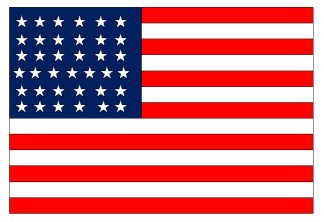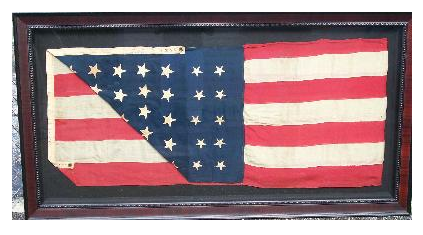Adding New Stars to the Flag of the Union During the Civil War
When Lincoln raised the flag over Independence Hall on Washington’s Birthday in 1861 (See Flag-Post.com article for December 12, 2012), he made it clear that he expected to see new stars added to the U.S. flag. In fact three stars were added to the flag’s blue union during the Civil War.

Thirty-three star U.S. flag lowered when Fort Sumter was evacuated at the beginning of the Civil War.
Although the thirty-three star flag was still official when Lincoln took the oath of office, Kansas had joined the Union, and the star for Kansas would not be added officially to the flag until the following July Fourth. The Kansas state motto, Ad Astra Per Aspera, which means “To the stars through difficulty” is especially appropriate as it reflects the political turmoil Kansans encountered before their state’s 34th star would be added to the flag. The term “Bleeding Kansas” describes a period of violent confrontations between pro-slavery and anti-slavery groups which erupted in Kansas Territory in a conflict that would foreshadow the Civil War. At one time there were two separate Kansas state governments competing for federal recognition. Finally, Kansas entered the Union as a Free State just as southern slave states lined up to secede.
The addition of the 35th star for West Virginia is perhaps the one case of secession that had Lincoln’s approval. Not secession of a state from the Union but secession of counties from a state; secession of counties from Virginia, a Confederate state. These counties in the northwestern corner of Virginia voted to remain in the Union and the new state of West Virginia entered the Union right in the middle of the Civil War in 1863.
Nevada entered the Union near the end of the Civil War in 1865, and the Nevada State Flag reflects this fact with the motto “Battle Born” which appears above a silver star in the flag’s canton corner. However, since Nevada’s star did not officially take its place in the U.S. flag’s starry union until the Fourth of July in 1865, Old Glory still had 35 stars at the time of Lincoln’s assassination.

Nevada’s “Battle Born” Star is now emblazoned on the State Flag.
Strangely, an error made some unofficial and incorrect 37 star flags part of the ceremonies surrounding Lincoln’s death. Immediately after the martyred president died, the Treasury department sent an urgent order for flags to the Annin Flag Company. Since Nevada had in fact become a state, officials wanted Nevada’s star to appear on flags displayed at Lincoln’s funeral. The telegram to Annin ordered flags with 36 stars for display at the funeral and at ceremonies in cities where memorial events would be held as the funeral train made its way from Washington back to Springfield for burial. The telegram from the Treasury Department to Annin ordered 37 flags each bearing 36 stars. However, either the telegram was not clear, or it was misunderstood. At any rate, Annin got it backwards and made 36 flags each bearing 37 stars. The flag with Nebraska’s 37th star would not become official until July 4, 1867, two years after Lincoln’s death; nevertheless, 37 star flags can be seen in photographs of memorial services held for Lincoln. Had they been regular 37 star flags, these Lincoln funeral flags would be almost impossible to distinguish from the 37 star flag that flew officially between 1867 and 1877. However, since this was a large order that had to be filled quickly, Annin made what was called “hasty” flags. As they were intended to be draped as part of wall decorations or to be used to cover Lincoln’s coffin, only one side of the flags would be seen. So, Annin produced 36 “hasty” flags with stars on one side only. Most of these incorrect 37 star flags have disappeared, but one of them is located in a Florida museum. That flag has a well documented chain of ownership to further identify it as one of Annin’s very rare “hasty” flags.
The next blog posting, planned as the last one in this series of Lincoln and the Flag, will tell the story of flags associated with Lincoln’s assassination. Did Old Glory take revenge on John Wilkes Booth, Lincoln’s assassin? What flag helped comfort the dying president? These questions will be answered in the next posting of Flag-Post.com.

The design for a Thirty-seven Star U.S. flag may have been used for Annin Flag Company’s Hasty flag, but it did not become the official U.S. flag until 1867.


